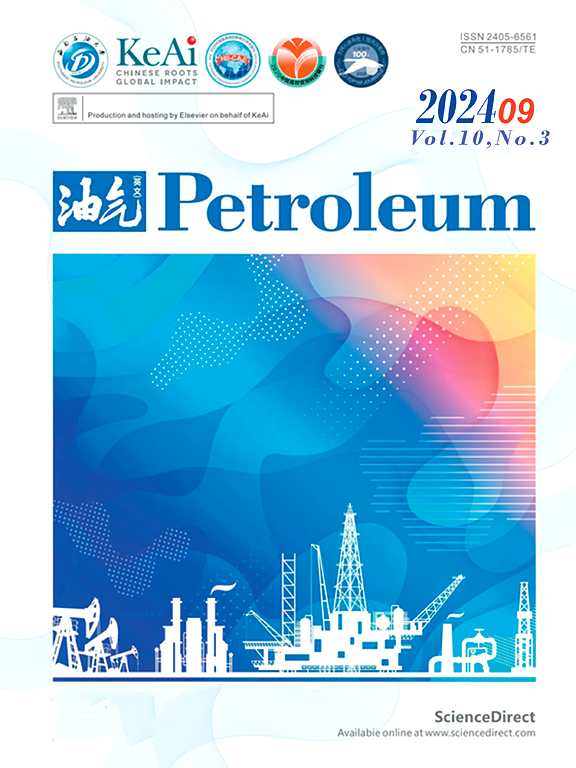Micro- and macroscopic experiments on self-adaptive mobility control and displacement efficiency of carbon-based composite nanofluid for enhanced oil recovery
IF 4.2
Q2 ENERGY & FUELS
引用次数: 0
Abstract
Reservoir heterogeneity, unfavorable water–oil mobility ratio, and high oil-water interface energy are primary constraints impeding macroscopic sweep and microscopic oil displacement efficiencies of water flooding reservoirs. Nanofluid's unique interface and small-scale effects offer significant potential in solving the low-universal problem of water flooding reservoir recovery. In the study, systematic micro- and macroscopic experiments, including microscopic visualization, core flooding, and nuclear magnetic resonance online flooding experiments, to reveal unique self-adaptive mobility control and superior displacement efficiency of amphiphilic graphene oxide (GOC)-based composite nanofluid. The results indicate that GOC nanosheets exert negative curvature at the oil-water interface, forming water-in-oil Pickering emulsion thermodynamically. These Pickering emulsions exhibit remarkable properties, with up to 90% internal phase volume and higher viscosity than oil across a broad water saturation, signifying GOC's self-adaptive mobility control in porous media. Furthermore, the Jiamin effect and in-situ thickening characteristics from the emulsion's micro-size compensate porous media heterogeneity, significantly improving the GOC nanofluid's macroscopic sweep efficiency. Moreover, a slight surfactant addition to the nanofluid further reduces oil-water interfacial tension to 10−2 mN/m and regulates the rock surface's hydrophilic wettability, notably improving microscopic oil displacement efficiency. Therefore, the remaining oil and residual oil after brine flooding have been effectively utilized and efficiently displaced. The composite nanofluid with 0.3–0.7 pore volumes enhances oil recovery by 15.8%–37.7% after ultimate brine flooding. Moreover, carbon-based nanomaterials' synthesis is eco-friendly, and both carbon-based composite nanofluid preparation and the injection process are simple. These advantages show nanotechnology's excellent industrial application potential in improving oil recovery efficiency.
碳基复合纳米流体自适应流动性控制及驱替效率的宏观微观实验研究
储层非均质性、不利的水油流度比和油水界面能过高是制约水驱油藏宏观波及和微观驱油效率的主要因素。纳米流体独特的界面和小尺度效应为解决水驱油藏低普遍性问题提供了巨大的潜力。本研究通过系统的微观和宏观实验,包括微观可视化、岩心驱油、核磁共振在线驱油实验,揭示了两亲性氧化石墨烯(GOC)基复合纳米流体独特的自适应迁移率控制和优越的驱油效率。结果表明:GOC纳米片在油水界面处产生负曲率,形成油包水Pickering乳状液;这些Pickering乳剂表现出非凡的性能,在很宽的含水饱和度下,其内相体积高达90%,粘度高于油,这表明GOC在多孔介质中具有自适应迁移率控制能力。此外,乳状液微观尺寸的嘉民效应和原位增稠特性补偿了多孔介质的非均质性,显著提高了GOC纳米流体的宏观波及效率。此外,在纳米流体中添加少量表面活性剂可进一步降低油水界面张力至10−2 mN/m,调节岩石表面的亲水润湿性,显著提高微观驱油效率。因此,盐水驱后的剩余油和剩余油得到了有效利用和高效驱替。孔隙体积为0.3 ~ 0.7的复合纳米流体在最终盐水驱后可提高采收率15.8% ~ 37.7%。此外,碳基纳米材料的合成是生态友好的,碳基复合纳米流体的制备和注射过程都很简单。这些优点表明纳米技术在提高采收率方面具有良好的工业应用潜力。
本文章由计算机程序翻译,如有差异,请以英文原文为准。
求助全文
约1分钟内获得全文
求助全文
来源期刊

Petroleum
Earth and Planetary Sciences-Geology
CiteScore
9.20
自引率
0.00%
发文量
76
审稿时长
124 days
期刊介绍:
Examples of appropriate topical areas that will be considered include the following: 1.comprehensive research on oil and gas reservoir (reservoir geology): -geological basis of oil and gas reservoirs -reservoir geochemistry -reservoir formation mechanism -reservoir identification methods and techniques 2.kinetics of oil and gas basins and analyses of potential oil and gas resources: -fine description factors of hydrocarbon accumulation -mechanism analysis on recovery and dynamic accumulation process -relationship between accumulation factors and the accumulation process -analysis of oil and gas potential resource 3.theories and methods for complex reservoir geophysical prospecting: -geophysical basis of deep geologic structures and background of hydrocarbon occurrence -geophysical prediction of deep and complex reservoirs -physical test analyses and numerical simulations of reservoir rocks -anisotropic medium seismic imaging theory and new technology for multiwave seismic exploration -o theories and methods for reservoir fluid geophysical identification and prediction 4.theories, methods, technology, and design for complex reservoir development: -reservoir percolation theory and application technology -field development theories and methods -theory and technology for enhancing recovery efficiency 5.working liquid for oil and gas wells and reservoir protection technology: -working chemicals and mechanics for oil and gas wells -reservoir protection technology 6.new techniques and technologies for oil and gas drilling and production: -under-balanced drilling/gas drilling -special-track well drilling -cementing and completion of oil and gas wells -engineering safety applications for oil and gas wells -new technology of fracture acidizing
 求助内容:
求助内容: 应助结果提醒方式:
应助结果提醒方式:


